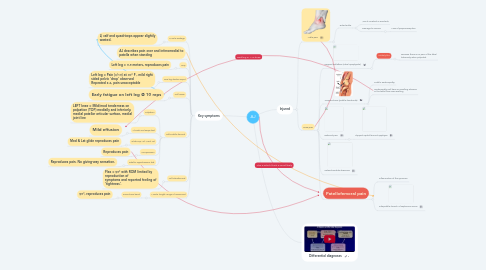
1. Key symptoms
1.1. Muscle wastage
1.1.1. L) calf and quadriceps appear slightly wasted.
1.2. AJ describes pain over and inferomedial to patella when standing
1.3. Hop
1.3.1. Left leg = 0.8 meters, reproduces pain
1.4. One leg decline squat
1.4.1. Left leg = Pain (6/10) at 60° F , mild right sided pelvic ‘drop’ observed Repeated x 4, pain unacceptable
1.5. Calf raises
1.5.1. Early fatigue on left leg @ 10 reps
1.6. Left Patello-femoral
1.6.1. Palpation
1.6.1.1. LEFT knee = Mild/mod tenderness on palpation (TOP) medially and inferiorly, medial patellar articular surface, medial joint line
1.6.2. A brush and swipe test
1.6.2.1. Mild effusion
1.6.3. Glide Sup, Inf, Med, Lat
1.6.3.1. Med & Lat glide reproduces pain
1.6.4. Compression
1.6.4.1. Reproduces pain
1.6.5. Patellar apprehension test
1.6.5.1. Reproduces pain. No giving-way sensation.
1.7. Left Tibiofemoral
1.7.1. Flex = 90° with ROM limited by reproduction of symptoms and reported feeling of ‘tightness’.
1.8. Muscle length, range of movement
1.8.1. Prone knee bend
1.8.1.1. 90°, reproduces pain
2. Injured
2.1. Ankle pain
2.1.1. Roled ankle
2.1.1.1. Was it inverted or everted?
2.1.1.2. Damage to Nerves
2.1.1.2.1. Loss of proprioreceptors
2.2. Knee pain
2.2.1. Osgood schlatters (Tibial apophysitis)
2.2.1.1. Unlikely this
2.2.1.1.1. Because there is no pain of the tibial tuberosity when palpated.
2.2.2. Jumpers knee (patellar tendonitis)
2.2.2.1. Patella Tendinopathy
2.2.2.2. Tendinopathy will have no swelling whereas in the tests there was swelling
2.2.3. Referred pain:
2.2.3.1. Slipped capital femoral epiphysis
2.2.4. Osteochondritis dissecans
2.2.5. Patellofemoral pain
2.2.5.1. Inflammation of the synovium
2.2.5.2. infrapatellar branch of saphenous nerve

